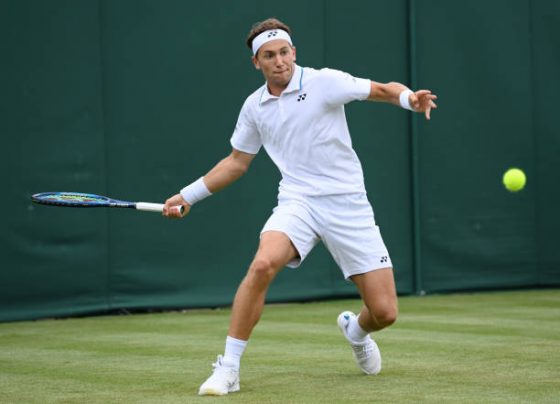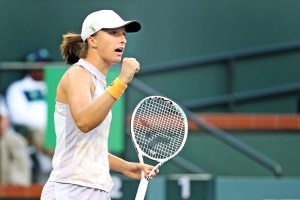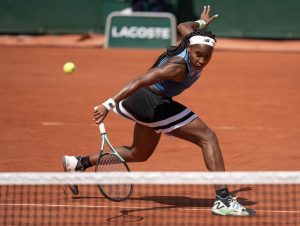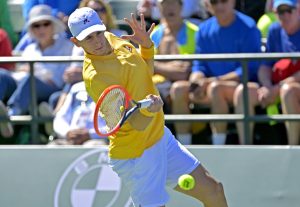It wasn’t quite as memorable as “Grass is for cows,” Manuel Santana’s famous criticism of grass-court tennis, but Casper Ruud’s recent comment that “Grass is for golf players” was still a worthy addition to what might be called the great grass-bashing canon. Seemingly for as long as tennis has been played, some players have openly wondered why it is played on grass, and if anything the question has become more common in the 21st century, when increasingly few events are played on the green stuff. Ironically, however, it is precisely because tennis is now so rarely played on grass that it is and probably always will be the ultimate test of a tennis player.
Casper Ruud Is Wrong
The Hard-Clay-Grass Breakdown
Tennis is almost unique in that it is a sport that is played on several different surfaces, predominantly hardcourt (the catch-all term for all artificial surfaces, ranging from the actual concrete of so many park courts to the DecoTurf of the US Open and the Plexicushion of the Australian Open), clay (as at Roland Garros and the rest of the European clay court circuit) and grass (as at Wimbledon and precious few other tournaments, certainly outside England). Only cricket comes close for being a sport that is so determined by the nature of the surface it is played on, and cricket is almost exclusively played on grass, although the bone-dry pitches of the Indian Subcontinent are so different from the lush, grassy pitches of England that it is hard to believe they are both made of the same basic material.
Principally because it is far easier to maintain hardcourts and clay courts (which, unlike grass, you don’t have to tend or mow), most tennis courts around the world are made up of one of those two surfaces, and the same is true in professional tennis. On both the ATP and the WTA Tours, roughly 60% of events are hardcourt; about 30% are clay; with about 10% (if that) being grass. Consequently, it is little wonder that players – even great players like Santana and Ruud – can struggle to adapt to playing on grass when they play on it so rarely, if at all, during the rest of the year.
Certainly, that was the case for Ruud this week in the Cinch Championship at Queen’s, the biggest warm-up event (at least for male players) before Wimbledon. Although he had made light of his “grass is for golfers” comment before his match with break-out British star Ryan Penistone, his true feelings about the surface – a mixture of uncertainty and nervousness, with perhaps a dash of fear thrown in, not least when he lost his footing, which was often – were perhaps revealed in his shock loss to the wild card player.
Its Rarity Value Is Exactly What Makes Grass So Special
Yet it is precisely because tennis is so rarely played on grass, especially now that Wimbledon is the only Major and indeed the only tournament above ATP500 ranking that is a grass-court event, that grass is the ultimate test of a tennis player. The natural attributes of grass, certainly when compared with hardcourt and even more so when compared with clay, are well-known: it is invariably faster; it is slippery and therefore more treacherous (as Casper Ruud was reminded of this week); and because it is an entirely natural surface, even more so than clay which often has at least some man-made elements within it, it is more inconsistent and likely to give way, leading to the kind of low bounces and even “air shots” that are so common on grass compared to other surfaces.
It is the combination of these unique natural elements of grass, combined with the rarity of grass court events in professional tennis, that make playing on it so demanding. And to make another comparison with cricket, just as it is felt within cricket that a player or team cannot be considered complete until they have succeeded on the Subcontinent, so it is arguable that a tennis player, however gifted they are on other surfaces, cannot be considered a complete player until they have succeeded on grass, and in particular at Wimbledon.
Does Nadal’s Relative Lack Of Success At Wimbledon Mean He Is Not Really The GOAT?
In the eyes of many, Rafael Nadal has unquestionably proven that he is the GOAT (Greatest Of All Time) by winning the first two Majors of the year. In doing so, he has made it “22 (Majors) in ‘22”. Now, having finally announced that he definitely hopes to play at Wimbledon, it is still possible that he will do what Novak Djokovic failed to do last year and what every other male player has failed to do since Rod Laver in 1969, namely win the Calendar Slam. To do so, however, he will have to win Wimbledon, on statistically his least favourite surface at a Major. He has “only” won Wimbledon twice, in 2008 and 2010, and although he has also “only” won the Australian Open twice, he has won four US Opens, giving him a total of six hardcourt Major wins.
Nadal’s dominance on clay is unquestionable, especially now that he has won an incredible 14 French Opens. However, it is arguable that he is ultimately the supreme clay-court specialist, with over two-thirds of all his Major titles coming on that one surface, for which his game could have been specifically designed – and in one sense, of course, it absolutely was designed by his first coach, Uncle Toni, who made him play tennis left-handed, even though he was naturally right-handed, to give him a “forehand” (or close to it) on both wings.
Nadal is now, statistically at least, the GOAT. But what statistics give, they can also take away, and if he has won over 60% of all his Majors on just the one surface, with a relative lack of success on other surfaces, then it is arguable that he is not really the greatest all-round tennis player of all time and that instead both his arch rivals, Roger Federer and Novak Djokovic, who have won the majority of their Majors on the faster surfaces of hardcourt and grass, are better all-round players, a fact that is disguised, or at least obscured, by Nadal’s utter annexation of clay-court tennis over the last 20 years.
However, before all the Rafaelites rise up in arms in defence of their man’s apparently unquestionable statistical greatness, there is a route open to Nadal to settle the GOAT argument once and for all, which is to win Wimbledon again, for a third time. Forget the Calendar Slam (and the US Open will be undoubtedly easier for him to win than Wimbledon) – if he wins Wimbledon again this year, to make it 23 Majors in total, with at least three Majors on each of the other two main surfaces on which tennis is played to go with his 14 clay-court Majors, then he can undoubtedly be considered the GOAT. And if his famous compatriot, Santana, could overcome his apparent allergy to grass to finally win Wimbledon, as he did in 1966, then his far more successful countryman has every chance of making it a hat-trick of titles in SW19 this summer.
Main Photo:
Embed from Getty Images






